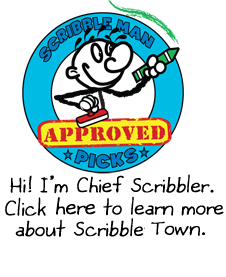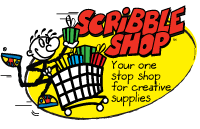Scribble Artist Interview with Amy Eisenfeld Genser!
Scribble Town (ST): From a distance what looks like a beautiful volcano of color and texture turns out to be an ingenious technique of rolled paper and paint. Amy Eisenfeld Genser has mastered the art of creating an organic effect by using mixed-media. Amy is also a mom of three sons from West Hartford, CT. She says, “I’m a tad obsessed with paper and paint, color, patterns, and texture.” You’ll soon see why!
Let’s start with, what does a day look like for you?
-

- Mineral Long Pink by Amy Genser
Amy Eisenfeld Genser (AEG): I am usually in my studio, on the third floor of my home. I work about five hours a day while my kids are in school. It is a juggling act. My typical day is to get the kids off to school, hit the gym for an hour, and then come home to work. Because my studio is in my home, it’s sometimes hard not to get “mess-tracted” as I call it (starting to do laundry, clean dishes, etc…) but having the studio on another floor helps. Going up the stairs is like crossing a threshold. I also listen to books on tape while I work. Time flies when I’m working on a piece and into a great story, but when I see the bus coming down my street at 3:45, my work day is over.
ST: I’ve never heard that term “mess-tracted” before, but I like it because I can completely relate to you! When you do get to your work, how would you define your art? It seems to be a peaceful combination of craft and fine art. I have never seen anything like it before.
AEG: I refer to it as mixed-media. I’ve been able to live in both the fine art and craft worlds. It’s nice to be welcome in both places.
ST: I can see how your artworks really settled nicely in the two worlds too. How did you discover this artistic process of paper quilling? Was there somebody that encouraged you?
AEG: Technically, my process is not quilling – I will outline my process below. I first started experimenting with paper during a papermaking class while studying for my MFA in Graphic Design at RISD (Road Island School of Design). My professor Jan Baker encouraged us to test the limits of what paper can be.

River Run by Amy Genser
ST: Where do you find yourself feeling really inspired to create? On your website (About page) you mention, “The sources of my work are textures, patterns, and grids. I look for forms that can be repeated to create a pattern when they are joined.” Please expand on that and if you have a story we’d love to hear it!
AEG: Most of my inspiration comes from nature because it is perfectly imperfect. I love all kinds of organic processes. They are visually intriguing and engaging. We spend a lot of our summers on the beach in Rhode Island. I love watching the water, the rocks, and the light. Our beach has rocks with these really neat barnacles and seaweed. Their colors are always changing. Sometimes there’s a lot of it, and sometimes just a little. It’s neat to watch the progression. One day when the seaweed was purple, brown, yellow and green, my husband made the awesome observation that nature never clashes. I love that.

Mineral Violet by Amy Eisenfeld Genser
In reference to my latest “mineral series”, I have always been drawn to gem-like colors. My mother is a jeweler who works with a lot of gemstones. I’ve grown up peering into tourmalines, garnet,diamonds, opals, citrine, etc. We always talk about how juicy and “lickable” the colors are. I have recently been looking at a lot of agate and geodes. The colors are simultaneously vibrant and translucent. Pretty amazing. I thought I’d take a stab at my own interpretation of them.
ST: So how do you turn your paper to look like gems, minerals, and other elements of life? What is the process?
AEG: Using Thai Unryu, I treat the paper almost as a pigment, layering colors one on top of the other to create different colors. My pieces are about a foot wide. Then I roll one layer on top of the other in all different thicknesses. I seal the roll with acid-free, archival glue stick, and then cut the long piece into sections with scissors or pruning shears. I have pruning shears of all different sizes to accommodate different widths.
ST: Wow! What a laboratory of processes! What forms of art do you include in your mixed-media paintings? What are some tools you like to use?
AEG: The actual rolling and cutting process is pretty quick. At this point I could pretty much do it in my sleep. It’s the composition/editing process that usually takes the longest. I paint my surface, either canvas or paper first, with acrylic and a lot of gel medium. Then I place my paper pieces on top and manipulate them until I have a satisfactory composition. It’s like putting a puzzle together, only I don’t know the final picture until I see it. I roll my pieces accordingly as I develop and build the piece. It’s a back-and-forth process. The paper and the piece lay on different tables in my studio. I attach the paper onto the canvas with PVA once I have the pieces where I want them.

Tall Tower by Amy Eisenfeld Genser
ST: Is there a song that moves you at the moment? Perhaps you can place a song with one of your works.
AEG: I can place a piece with a book on tape – one of my favorite- Prince of Tides” by Pat Conroy. I usually listen to books on tape while I work. My head is usually in the story, and my hands are free to do what they need to do.
ST: The titles of your pieces are very revealing and help the viewer guide how they can look your work. How do you come up with these titles?
AEG: Usually it had to do with the inspiration for the piece. I just look at the work and figure out a title. They always feel a little uncomfortable and arbitrary to me. It’s hard for me to give words to something that is visual.
ST: Amy, what’s a piece of advice you can give our Scribblers?
AEG: Have fun! Do what feels good. Keep your hands busy and the work will follow along. There’s nothing like getting rid of creative energy through using your hands. I was that kid who was always weaving potholders on the plastic loom and making complicated patterns in woven friendship bracelets.
ST: Thanks Amy for sharing so much with us! Amy has shared an activity for us to get started on our own artwork. Check out Scribble Shop for more details:
http://www.scribbleshop.com/content/roll-it-your-wonder-amy-eisenfeld-genser

Portrait of Amy Eisenfeld Genser




 Photo: “Fly Away Dandelions,”
Photo: “Fly Away Dandelions,”  Photo: “Light Blue Wishes,” SVPPLY
Photo: “Light Blue Wishes,” SVPPLY





 A Sunday Afternoon on the Island of La Grande Jatte (1884-86) by Georges Seurat
A Sunday Afternoon on the Island of La Grande Jatte (1884-86) by Georges Seurat The Papal Palace, Avignon (1900) by Paul Signac
The Papal Palace, Avignon (1900) by Paul Signac

 Photo:
Photo: 




 Photo:
Photo:  Photo:
Photo: 






 Photo:
Photo:  Photo:
Photo: 




